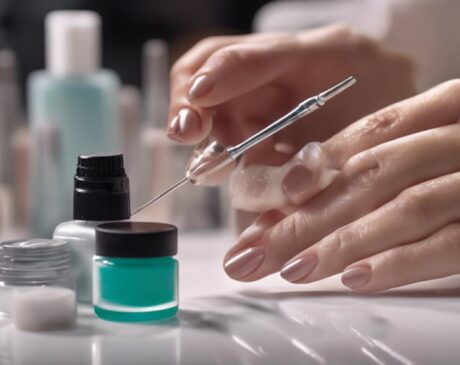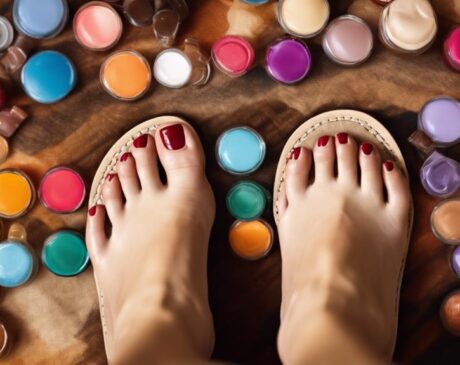Can I Just Put Base Coat on My Nails?
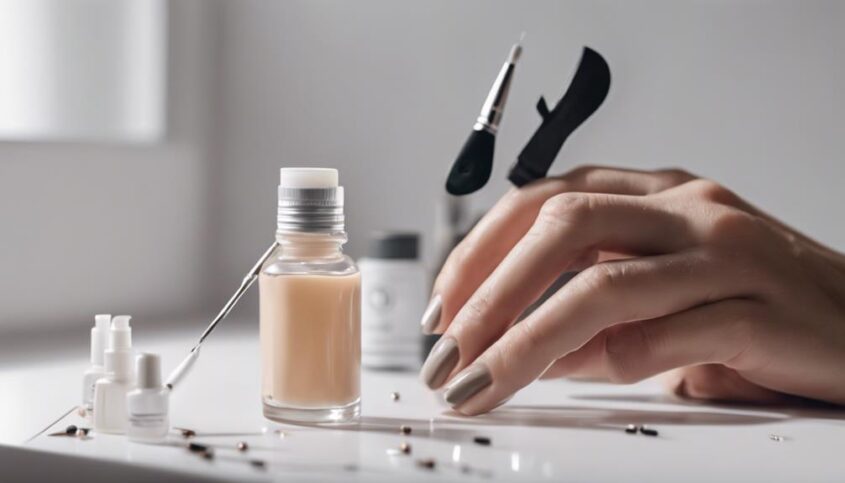
Yes, you can apply just a base coat on your nails. It serves as a protective layer and can prevent discoloration and nail damage. However, it may lack the vibrant color and glossy finish provided by a complete manicure. Also, it can be more susceptible to chipping without a top coat. Whether your preference is a natural look or you desire to strengthen your nails, a base coat can be beneficial. If you are curious about the effects of longer term use or alternative nail care solutions, there's an abundance of information available for further exploration.
Key Takeaways
- Applying only base coat can provide a protective layer against discoloration and damage to your nails.
- Base coat alone lacks the vibrant color and glossy finish of a full manicure and is more susceptible to chipping.
- Regular base coat application can lead to strengthened nails but excessive use without proper care can cause dryness and brittleness.
- A base coat can provide a smooth surface for polish application and enhance the longevity of a manicure.
- Experimenting with your nail routine, like varying the number of base coat layers, can help find what works best for your nails.
Understanding the Base Coat
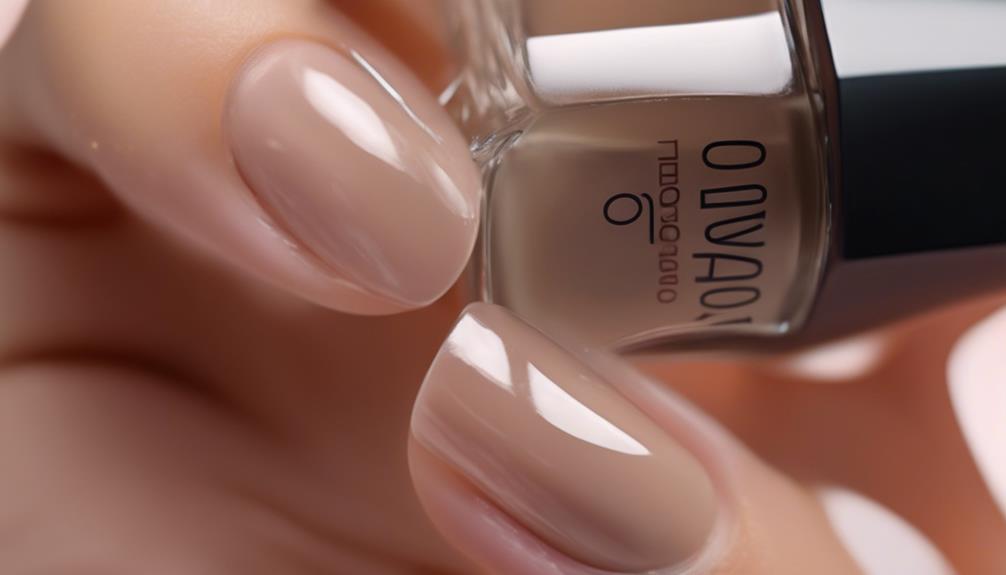
A base coat, an essential component in nail care, serves as a protective layer that shields the nails from possible damage while enhancing the longevity of the nail polish. It plays a critical role in the nail beautification process, and its importance cannot be underestimated in contemporary nail care innovations.
The sophistication of a base coat lies predominantly in its composition. The base coat ingredients form a complex amalgamation of nourishing elements and protective agents. They typically include solvents, plasticizers, film formers, and resins. These ingredients work synergistically to provide the base coat with its unique properties.
In the pursuit of innovation and catering to diverse consumer needs, several base coat alternatives have emerged. These include ridge filling base coats, which smooth out the nail surface, or strengthening base coats, fortified with minerals and vitamins to promote healthy nail growth.
Understanding the base coat and its alternatives is crucial for making an informed decision and achieving the desired result. It's a testament to the innovation in nail care, blending science and beauty to deliver impressive outcomes.
Purpose of a Nail Base Coat
Serving multiple purposes, a nail base coat primarily functions as a barrier, safeguarding the nail from potential discoloration and damage that could occur from the application of colored nail polish. The ingredients in the base coat also play a significant role in ensuring a smooth and even application of the polish, leading to a more flawless and long-lasting manicure.
The base coat ingredients often include a blend of resins and plasticizers which provide adhesive properties and flexibility, ensuring the nail polish adheres better and lasts longer. Additionally, some base coats may contain proteins, vitamin E, and aloe vera to nourish and protect the nails.
In the constantly evolving beauty landscape, there is an increased demand for eco-friendly options. As a solution to this, many brands are now offering base coats devoid of harmful chemicals like toluene, formaldehyde, and dibutyl phthalate. These eco-friendly base coats not only protect the nails but also ensure consumer safety and environmental sustainability. The base coat, thus, serves as a critical first step in any nail painting process, combining both functional and aesthetic benefits.
Base Coat Application Basics
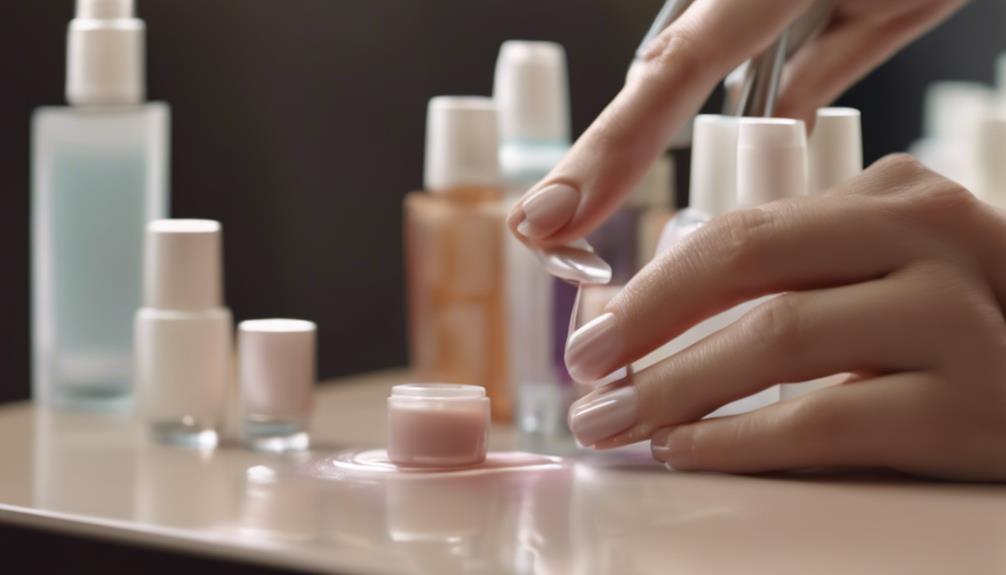
To achieve a professional-looking manicure, understanding the basic steps for applying a base coat is of paramount importance. Utilizing innovative application techniques can not only enhance the aesthetic appeal of your nails but can also significantly improve coat durability.
First, ensure your nails are clean and dry. Any moisture or leftover polish can interfere with the adhesion of the base coat. Apply a thin layer of the base coat starting from the cuticle and moving towards the tip of the nail. It's crucial to cover the entire surface to ensure uniform protection.
Next, let the base coat dry completely before applying any additional coats or color. This step is vital for coat durability as it allows the base coat to form a solid foundation, thereby reducing the chances of chipping or peeling.
Finally, for a sleek and professional finish, apply the base coat in three strokes: one down the middle and one on each side. This technique ensures even distribution and minimizes streaks.
Mastering these base coat application basics can transform your at-home manicure experience, offering a salon-quality finish that is durable, visually appealing, and cost-effective.
Pros and Cons of Base Coat Only
While the application of a base coat is generally recommended in nail care, employing it as a standalone product has its own merits and drawbacks. It is important to understand these factors in order to make an informed decision about your nail care routine. Let us now explore the benefits as well as potential downsides of using only a base coat on your nails.
Benefits of Base Coat
Why is a base coat considered an essential part of any manicure routine? The benefits of using a base coat are plentiful, and they extend beyond just aesthetics. Base coat ingredients typically include proteins, vitamin E, and calcium which nourish the nails while preventing staining. Regardless of the base coat brands you prefer, these benefits are universal:
- Provides a smooth surface for polish application
- Prevents nail staining from colorful polish
- Enhances the longevity of your manicure
- Strengthens and nourishes the nail
- Helps the color polish adhere better to the nail
These points underscore the value of base coats in nail care. They create a healthier, more appealing nail appearance, making them a crucial step in any manicure routine.
Drawbacks of Solo Use
Despite the numerous advantages of using a base coat in a manicure routine, solely relying on it also presents certain drawbacks. The first of these is the potential for base coat allergies. While rare, some individuals may have reactions to specific ingredients used in base coats. This is why ingredient analysis is critical for users who may have sensitive skin. Furthermore, base coats alone do not provide the vibrant color and glossy finish that a complete manicure offers. Also, without a top coat, a base coat is more susceptible to chipping, reducing the longevity of the manicure. Hence, for those seeking innovation in their nail care, a comprehensive approach involving base coat, color, and top coat might be more beneficial.
Long-Term Effects on Nails
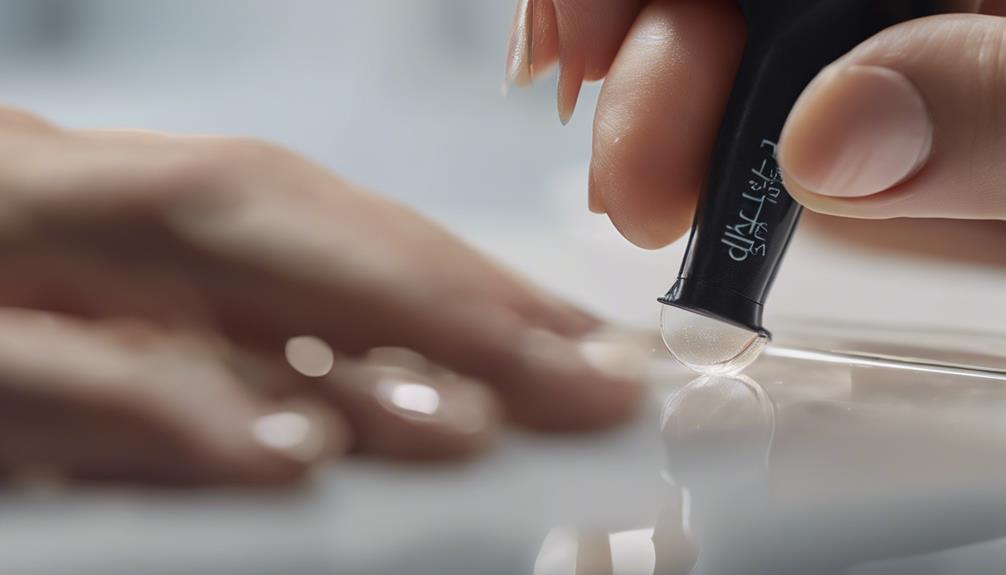
Regular application of a base coat can significantly affect the health and appearance of your nails over the long term. The base coat, a crucial component of the manicure routine, is primarily designed to create a smooth surface for the polish, extend polish longevity, and protect the nail from potential discoloration.
However, when used without a color coat or top coat, the base coat affects the nails in ways that can either be beneficial or detrimental depending on various factors. Here's a look at some long-term effects:
- Over time, continuous application of base coat can lead to strengthened nails, reducing breakage.
- Frequent use can aid in maintaining the natural moisture of the nails.
- Conversely, excessive use without proper nail care can cause dryness and brittleness.
- It might result in a yellow tinge on the nails if the base coat quality is poor or if it's used excessively.
- Prolonged usage without a break can lead to nail plate damage due to the lack of exposure to natural elements.
Alternative Quick Nail Care Solutions
Are you in need of quick nail care solutions that can be alternatives to the regular application of a base coat? We understand that time is precious and the conventional nail care routine may not always be feasible. There are convenient and innovative alternatives available that promise both efficiency and effectiveness.
Quick manicures are one viable alternative. These provide a fast and easy way to achieve well-groomed nails. Many nail salons offer express manicure services that include shaping, buffing and a single coat of polish. This simplified procedure significantly reduces the time spent on nail care without compromising on the end result.
DIY treatments are another great solution for the time-strapped. You can create your own nail strengthening solutions at home using common household items like olive oil, lemon juice, and garlic. These natural ingredients are known for their restorative properties and can help maintain nail health when used regularly. Furthermore, the process of creating and applying these DIY treatments can be quite therapeutic, adding another dimension to your nail care routine.
Expert Opinions on Base Coat Use
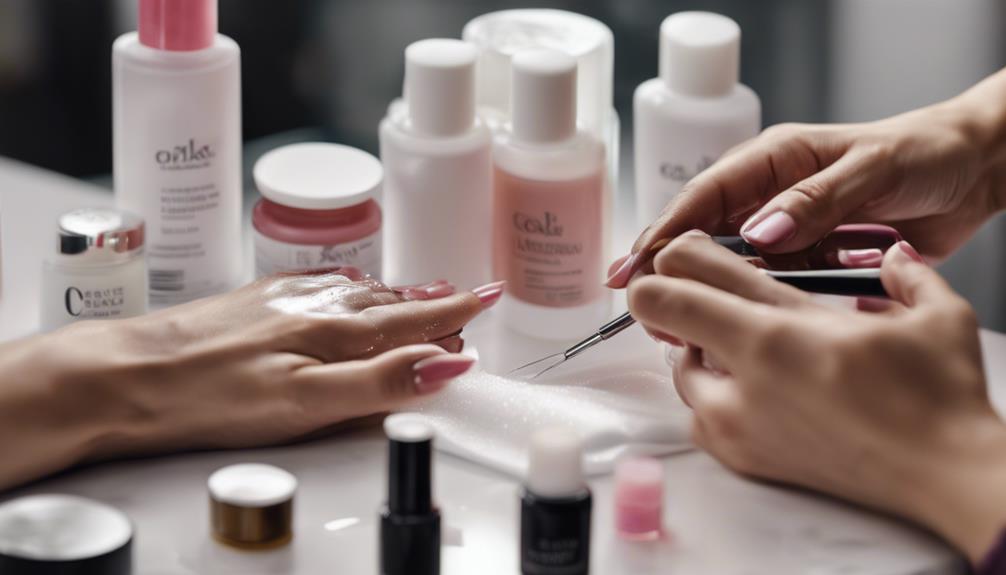
Professional nail technicians and beauty experts universally emphasize the importance of a base coat in a successful manicure. The consequences of skipping this crucial step can be detrimental to the health and appearance of your nails. In the following section, we'll explore their insights on why a base coat is indispensable and the potential repercussions of neglecting it.
Importance of Base Coat
Underscoring the significance of a base coat, numerous beauty experts assert its vital role in nail health and polish longevity. Base Coat Chemistry reveals that it provides a barrier, protecting the nail from potential damage caused by colored polish. It also creates a smooth surface for the polish to adhere to, promoting a colorless manicure that lasts longer and looks more professional.
Here are five key benefits:
- It prevents staining and peeling of the nails.
- Enhances the longevity of the nail polish.
- Improves the look of the colored polish.
- Nourishes the nails, promoting overall nail health.
- Acts as an adhesive for the colored polish, making application easier.
Hence, a base coat should never be skipped in the pursuit of perfect nails.
Skipping Base Coat: Consequences
Neglecting to apply a base coat may seem like a time-saving step, however, experts in the field of nail care warn of the negative consequences that can arise from this oversight. One primary concern is nail discoloration prevention. Without the protective layer of a base coat, nails are exposed to the pigments in colored nail polish, leading to unsightly yellowing over time.
Contrary to base coat myths, this preliminary step does more than just extend the life of your manicure – it also provides a barrier against potential nail damage from repeated polish application and removal. The innovative solution is clear: including a base coat in your routine is an essential strategy for maintaining healthy, vibrant nails.
Experimenting With Your Nail Routine
In the realm of nail care, incorporating a base coat into your routine can offer a myriad of benefits, paving the way for healthier and more appealing nails. As you delve into the art of nail care, creating a customized nail regimen that suits your personal needs and preferences is essential. One way to achieve this is through nail art experimentation.
Experimenting with your nail routine can breathe new life into your overall nail care regimen. Here are a few suggestions:
- Experiment with different base coat brands. The right product can enhance the longevity and appearance of your nail art.
- Try varying the number of base coat layers. Often, a single layer suffices, but you might find that additional layers provide a smoother canvas for your nail art.
- Change up the drying times between coats. This can affect the end result of your nail art.
- Play around with various nail art styles. From minimalist designs to intricate patterns, the possibilities are endless.
- Experiment with different top coats. Some can give a glossy finish, while others provide a matte look.
Frequently Asked Questions
What Are Some Recommended Brands for a Nail Base Coat?
In the realm of nail care innovation, exploring organic base coats is advisable. Brands like Zoya Anchor Base Coat and Orly Bonder offer benefits of vitamin infusion, promoting healthier and stronger nails.
Are There Any Side Effects of Using a Base Coat Frequently?
Frequent application of a base coat may cause dryness and brittleness in nails. Additionally, base coat allergies, although rare, can occur due to specific ingredients. Regular moisturizing can help mitigate these effects.
Can I Apply a Top Coat Over a Base Coat Without Adding Color in Between?
Absolutely, you can apply a top coat directly over the base coat. This will enhance the base coat's longevity while preserving its ingredients, offering an innovative, minimalistic approach to nail care.
How Do I Remove the Base Coat From My Nails Properly?
To properly remove a base coat from your nails, gently use an acetone-based nail polish remover. For those with base coat allergies, natural alternatives like lemon juice and vinegar may be suitable, yet innovative solutions.
Is It More Beneficial to Use a Base Coat or a Nail Hardener for Weak Nails?
For weak nails, the choice between a base coat and nail hardener depends on individual needs. While base coat ingredients provide protection, hardener application techniques offer strength, revolutionizing nail care for those seeking innovative solutions.

